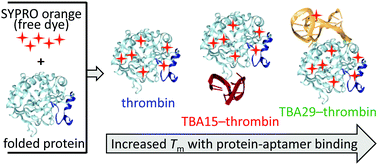Aptamer-induced thermofluorimetric protein stabilization and G-quadruplex nucleic acid staining by SYPRO orange dye†
Abstract
SYPRO Orange™ is a commercial dye commonly employed in a thermofluorimetric analysis (TFA) to stain thermally-denatured proteins and obtain their melting temperature (Tm values). Herein, the ability of DNA–aptamer-based ligands to increase protein target melting temperature (Tm) was investigated and a correlation between protein target thermal stability (ΔTm) and DNA–aptamer protein binding affinity (Kd) was found. Also, a serendipitously discovered nucleic acid staining property of SYPRO Orange dye has been revealed while performing the TFA of thrombin. The dye specifically binds to G-quadruplex (GQ) forming nucleic acids, such as the 29-mer thrombin binding aptamer (HD22 or TBA29) and hemin binding aptamer (PS2.M) providing a ‘turn-on’ fluorescence response. Our studies demonstrate that protein stability is proportional to aptamer binding affinity in aptamer–protein complexes and establish the potential of SYPRO Orange for nucleic acid staining applications.



 Please wait while we load your content...
Please wait while we load your content...